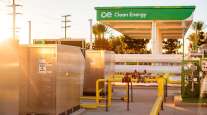Truck, Engine Makers See Natural Gas as Practical Alternative to Diesel Fuel
This story appears in the April 2 print edition of Transport Topics. Click here to subscribe today.
LOUISVILLE, Ky.—Truck and engine manufacturers at the Mid-America Trucking Show here declared natural gas the victor in the industry’s search for a practical alternative fuel to diesel, saying they could have three different types of natural-gas engines by 2013 and a nationwide network of 100 fueling stations that offer it by 2014.
“Natural gas will be the star of this year’s Mid-America Trucking Show,” Ed Pence, general manager of independent engine maker Cummins Inc.’s heavy-duty engine business, told reporters here March 20.
Navistar Inc., which builds International trucks, announced at MATS that it would begin offering the 8.9-liter Cummins Westport ISL G engine this year. It added that next year it would begin to offer “dual use” MaxxForce 13, engines developed with Clean Air Power, which burn 85% natural gas and 15% diesel.
Navistar’s decision meant that all North American heavy-duty truck brands except Western Star would offer the 8.9-liter ISL G.
Cummins Westport, a 50-50 joint venture between Cummins and Westport Innovations Inc., Vancouver, British Columbia, also unveiled at MATS the Cummins Westport ISX12 G, a 12-liter natural gas engine for regional-haul, truck/tractor, vocational and refuse applications.
Cummins’ Pence said that he believed the federal government will certify the ISX12 G in 2013, and it will go into full production next year.
Kenworth Truck Co. and Peterbilt Motors Co., both part of Paccar Inc.; Freightliner trucks, a subsidiary of Daimler Trucks North America; and Volvo Trucks North America all announced at MATS that they would offer the larger Cummins Westport ISX12 G engine.
Westport Innovations also builds its own Westport HD, a 15-liter engine that runs on liquefied natural gas (LNG). It purchases Cummins ISX 15-liter engine blocks, adding components so that it runs on LNG. Cummins does not have a financial stake in that business.
Cummins also announced that it was developing its own 15-liter natural-gas engine, which will be ready for testing next year. Pence said that a full launch was expected in 2015.
Cummins said its decision to build the big-bore model was based on the growing infrastructure and demand by its over-the-road customers for a natural-gas engine.
Navistar Inc. offered a panel discussion March 21 on the growing use of natural gas; it drew at least 700 dealers and customers. The panel featured investor T. Boone Pickens, an oil business veteran who helped to start the current interest in natural gas less than 10 years ago “by investing $100 million of my own money,” he said.
The common theme from all companies and investors was that huge supplies of natural gas in North America have begun to be exploited recently, providing a plentiful supply of domestically produced fuel at lower prices than petroleum-based products.
“With recent discoveries, energy experts have raised their estimates of proven natural-gas reserves in the United States to more than a 100-year supply, and it will also always be hugely less expensive than diesel, remaining in the range of the equivalent of $1 to $1.50 a gallon cheaper,” Pickens said. “We have the equivalent of three times more natural gas than Saudi Arabia has oil, and it’s right here in the United States.”
Pickens said North America could be independent of imported fuel in six to seven years.
“Obviously, the new natural gas developments will have much deeper effects in the North American economy than just on us truck manufacturers,” said Daniel Ustian, Navistar’s chairman and CEO, also on the panel, “but our industry has made many attempts to develop different types of alternative fuel trucks in recent years, with only minimal success. Why natural gas will work is because it will stand on its own from a commercial standpoint that will not depend on government incentives.”
Jimmy Haslam, CEO of Pilot Flying J Travel Centers — one of the largest truck stop chains in the country — assured the panel’s audience they would be able to fill up nationwide with LNG within two years.
“We have 10 truck stops that offer LNG today and will have 100 by the summer of 2014, strategically placed for nationwide routes,” Haslam told the audience. “If the demand jumps up even higher, we can ramp up faster.”
Haslam said that he expected the over-the-road market to be nearly 100% LNG because of the weight of compressed natural gas tanks. CNG is more suitable for local uses such as refuse and pickup-and-delivery, he said.
Pilot is making the natural-gas investment in cooperation with Clean Energy Inc., a natural gas supplier in which Pickens is a major investor, and Chesapeake Energy Corp., which described itself as the second-largest producer of natural gas in the United States.
Thomas Price Jr., Chesapeake Energy’s senior vice president for corporate development and government relations, assured the audience that LNG will keep its effective price advantage of $1 to $1.50 less than diesel for at least 10 years, “and the difference will probably expand as we find more natural gas.”
Although LNG is stored at temperatures of minus 260 degrees Fahrenheit, Pilot Flying J’s Haslam said he did not expect drivers to encounter any problems or danger in filling their LNG tanks.
“Yes, they’re supposed to wear a special glove, but the seal is airtight, and I see it as bringing the same problems as refilling urea tanks” on trucks using selective catalytic reduction, Haslam said. “It turned out to be very simple and no problem as all.”




